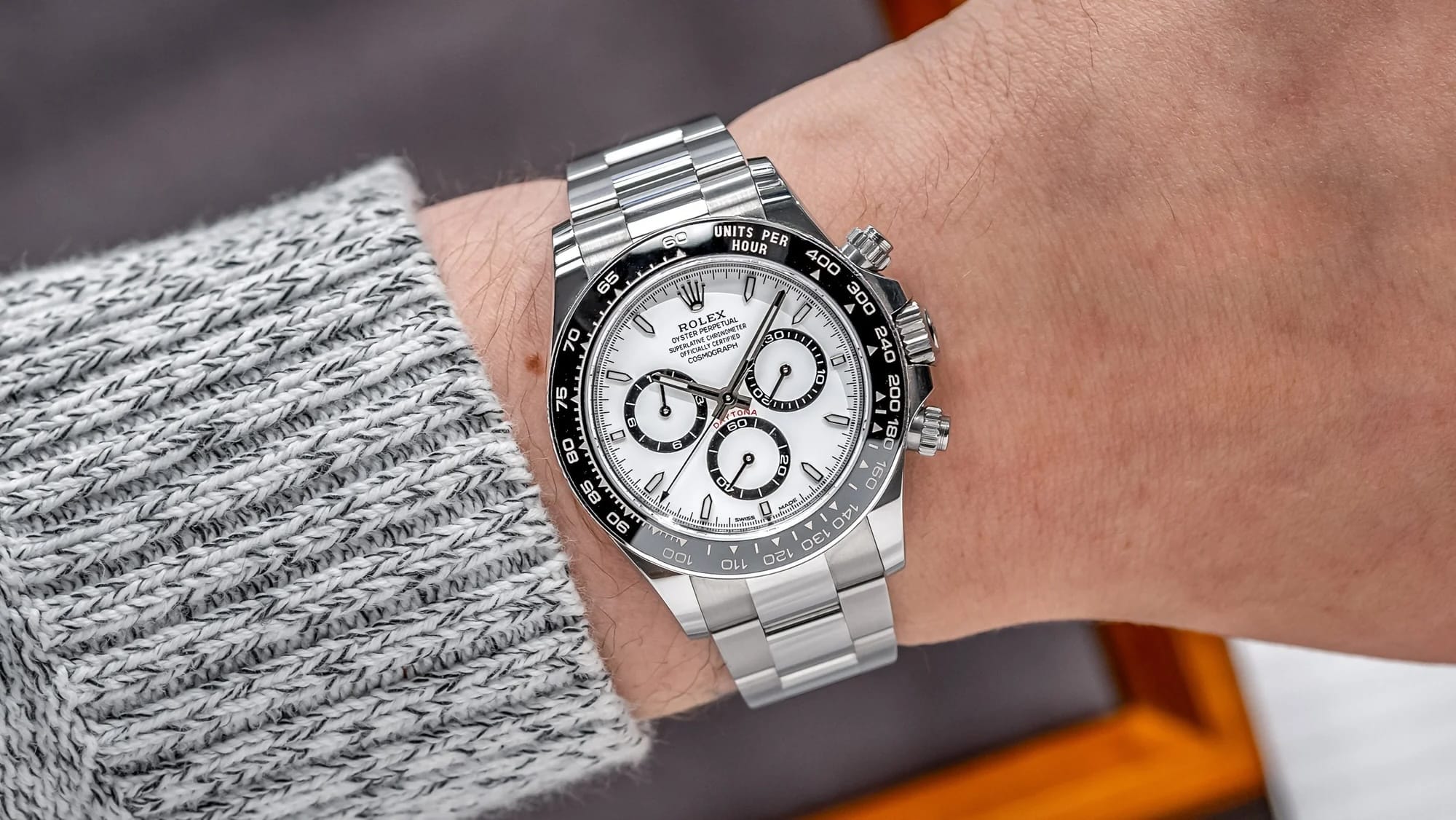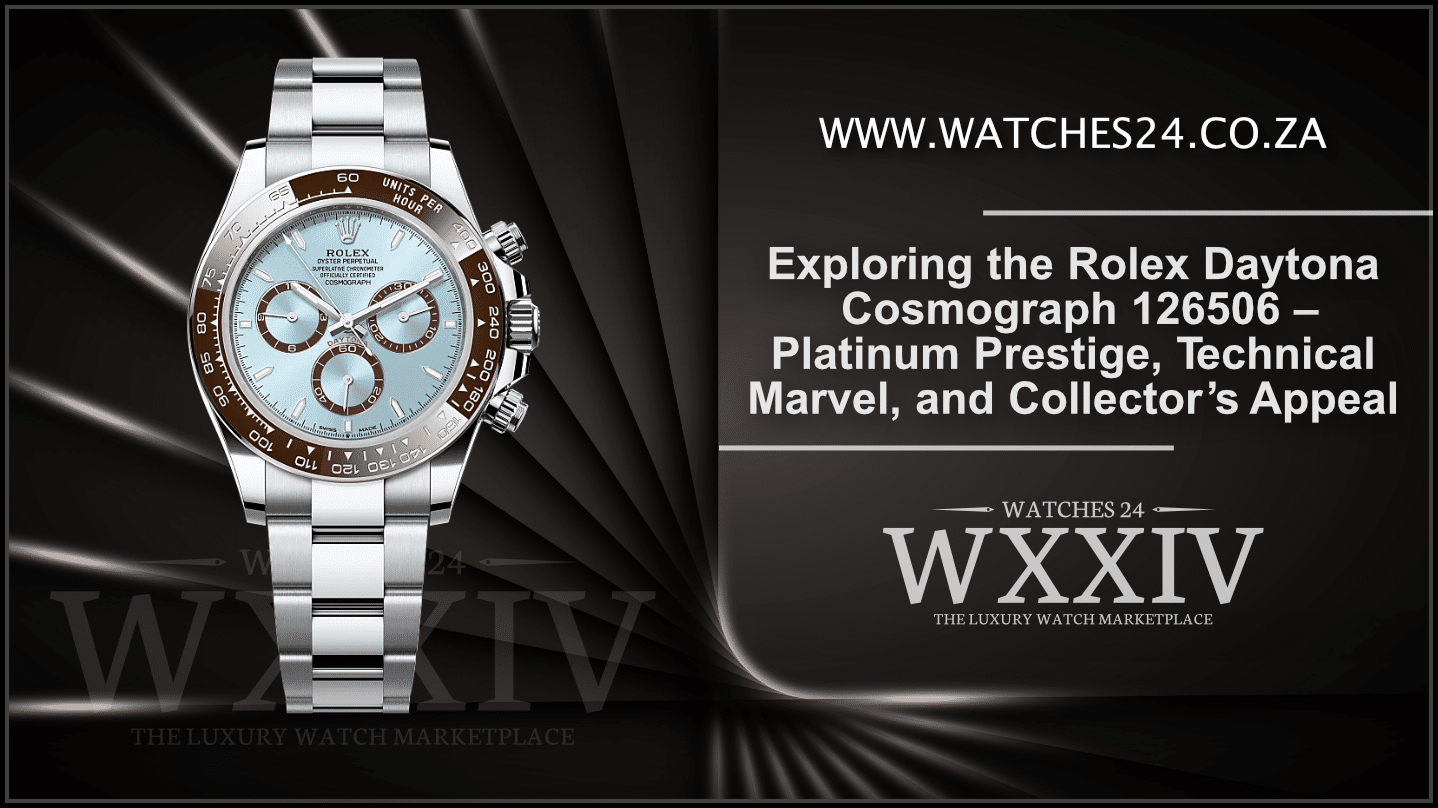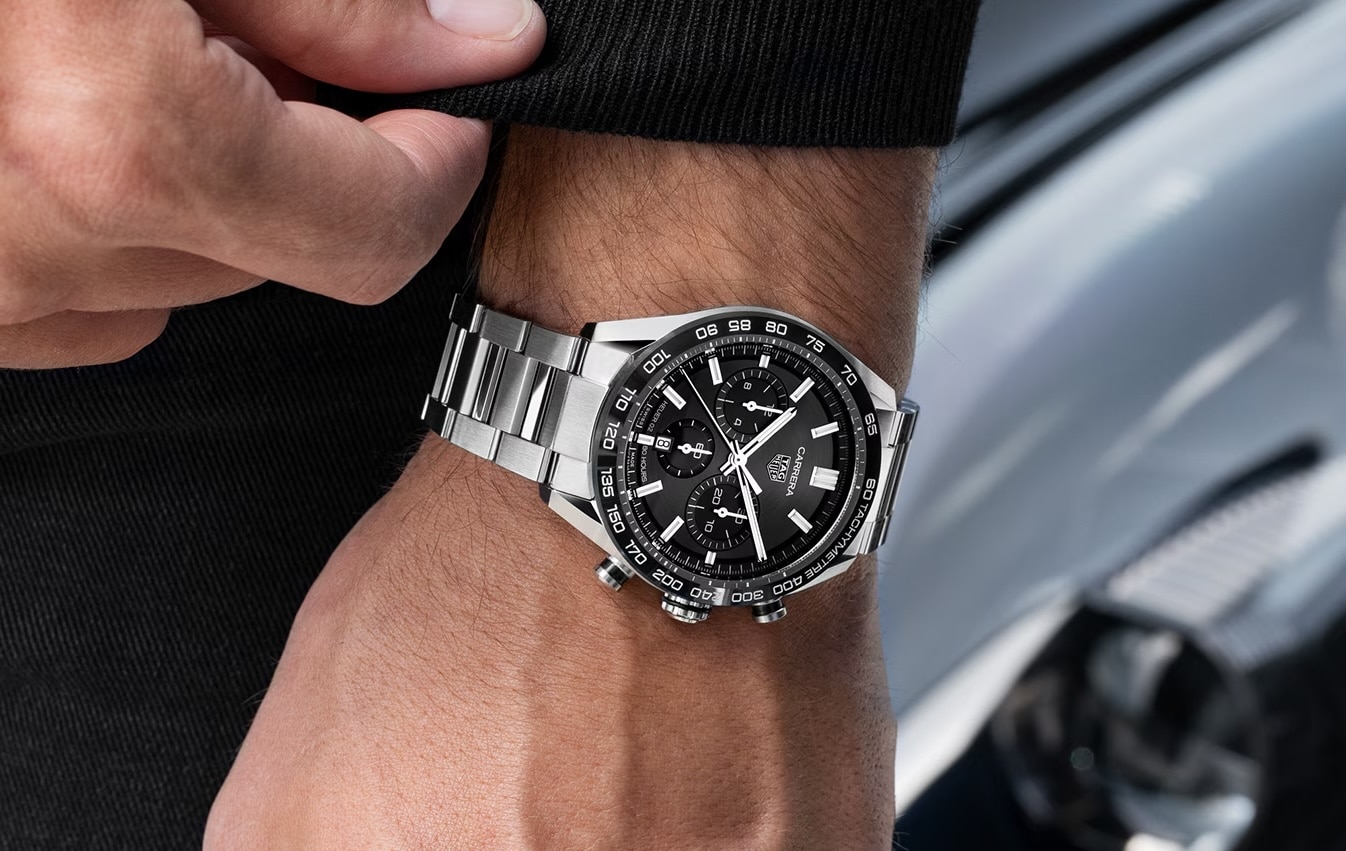
Rolex Daytona
Rolex Daytona represents more than just high-end watchmaking, as it embodies motorsport heritage alongside chronometric


In 2025, Rolex introduced a significant evolution to its GMT-Master II collection by incorporating two new and unconventional dial materials: ceramic and tiger iron. These developments reflect the brand’s ongoing commitment to material innovation and aesthetic enhancement within its sports watch category.
This article explores the technical and design implications of these updates, focusing on the integration of Cerachrom (Rolex’s proprietary ceramic) and tiger iron stone into the dials of the GMT-Master II. These material innovations not only introduce visual diversity but also demonstrate Rolex’s continued experimentation with combining precious metals, modern materials, and advanced production techniques.
Ceramic Dials: Cerachrom Enters the Dial Surface
Rolex has long used Cerachrom for its bezel inserts, prized for its resistance to scratching and fading. However, the 2025 release marks the first time this material has been applied directly to the dial of a Rolex watch.
Reference 126729VTNR: White Gold GMT-Master II with Green Ceramic Dial
The Rolex GMT-Master II reference 126729VTNR features a green ceramic dial combined with a black and green Cerachrom bezel. The use of green for the dial—crafted from ceramic—distinguishes it from traditional lacquer or sunburst-finished dials that Rolex has historically favored.
The case measures 40mm and is constructed from 18-karat white gold. It retains the “destro” layout (left-handed crown configuration) first introduced in previous GMT-Master II iterations, particularly on the steel variant known colloquially as the “Sprite.” The date window is positioned at 9 o’clock instead of the traditional 3 o’clock, aligning with the left-handed orientation.
Inside, the watch is powered by the Caliber 3285, an automatic movement developed entirely in-house by Rolex. This movement features a 70-hour power reserve and Rolex’s “Superlative Chronometer” certification, indicating timekeeping precision of -2/+2 seconds per day. It supports dual time zones, facilitated by a centrally-mounted GMT hand.
Technical Structure of the Ceramic Dial
The green dial itself is not made from a single solid piece of ceramic. Instead, it consists of a ceramic disc mounted onto a brass base plate. This construction mirrors the method used for Rolex’s stone dials, in which a thin sheet of decorative material is applied to a stabilizing base. The use of a brass underlayer provides the necessary structural integrity, as pure ceramic—while hard—is more brittle and vulnerable to cracking under stress.
Though visually distinct, the ceramic dial does not exhibit a high-gloss surface commonly associated with ceramic materials. Instead, it displays a softer luster that differs from the bezel’s shinier appearance. This nuanced visual texture results from the way light interacts with the ceramic’s surface finish.
Rolex’s decision to employ ceramic in this application introduces an alternative to lacquered or enamel dials, expanding the visual language of the GMT-Master II line while leveraging the known durability of ceramic materials.
Tiger Iron Dials: Natural Stone in Watchmaking
Alongside the green ceramic version, Rolex also introduced tiger iron dials to its GMT-Master II lineup—marking the first use of this composite stone in the brand’s history. Tiger iron is a naturally occurring material composed of three distinct minerals: tiger’s eye, red jasper, and hematite. When sliced and polished, tiger iron reveals layered bands of varying colors and patterns, resulting in a dial surface that is both dynamic and unique.
Stone Composition and Aesthetic Qualities
Tiger iron is formed through sedimentary layering processes over geological timeframes. Each dial displays a unique striation pattern, as the orientation of the mineral cut reveals the distinctive layers of yellow-gold, red, and dark metallic gray. This randomness ensures that no two dials are identical, further enhancing the exclusivity of each timepiece.
New Models Featuring Tiger Iron Dials
Two GMT-Master II models feature this dial material:
– Reference 126715CHNR: 18-karat Everose gold case on an Oyster bracelet
– Reference 126718GRNR: 18-karat yellow gold case on a Jubilee bracelet
In both models, the tiger iron dial is paired with the GMT-Master II’s classic two-tone Cerachrom bezel, showcasing brown and black colorations. The contrast between the warm hues of the stone and the gold cases contributes to a cohesive and luxurious aesthetic.
The choice of bracelet further differentiates the two models. The Everose gold version is presented with an Oyster bracelet, which is characterized by its broader, sportier links. The yellow gold version features a Jubilee bracelet, offering a more intricate and elegant link pattern. These bracelet styles complement the visual complexity of the tiger iron dial, although some collectors may find the simpler Oyster bracelet better suited to balance the dial’s inherent visual activity.
As with the ceramic model, both tiger iron dial watches are powered by the Caliber 3285 movement and share the same case dimensions and functionality.
Production Techniques and Challenges
Working with unconventional dial materials presents several technical challenges. Cerachrom, being extremely hard, requires specialized tools and precise fabrication techniques to avoid damage during shaping or finishing. The process of affixing a ceramic disc to a metal base demands exact alignment and bonding to ensure long-term durability and uniformity.
Stone dials, including those made from tiger iron, are even more delicate to produce. The mineral must be cut into ultra-thin slices—often less than one millimeter thick—to fit within the tolerances of the watch’s construction. These slices are then polished and inspected for defects before being adhered to a metal plate. Due to the heterogeneous nature of natural stone, fracture lines and inconsistencies are common, which significantly reduces usable yield and raises production costs.
Rolex’s ability to incorporate these materials into a functional sports watch environment speaks to the brand’s advanced manufacturing capabilities. Stone dials have traditionally been reserved for dress watches due to their fragility; incorporating them into a robust GMT platform represents a technical and design advancement.
Design Implications and Market Positioning
By introducing both ceramic and stone dials in the same product family, Rolex offers consumers distinct aesthetic choices within a familiar framework. The green ceramic dial provides a modern, understated option that emphasizes innovation in materials science, while the tiger iron dial offers a natural, artisanal look that aligns with broader luxury trends in natural materials and uniqueness.
These additions serve to differentiate the GMT-Master II collection from other Rolex sports watches such as the Submariner or Explorer, by offering higher degrees of visual expression and exclusivity. Both models also reaffirm Rolex’s strategy of introducing material novelties primarily within its precious metal references, which are often positioned at the higher end of its catalog.
Comparison with Previous Material Experiments
Rolex has a history of experimenting with non-traditional dial materials. Past examples include:
– Meteorite dials, used in models such as the Day-Date and previous GMT-Master II references, offering a unique crystalline surface structure
– Eisenkiesel, a form of quartz with iron inclusions, used in limited applications for its natural veining and metallic glow
– Mother-of-pearl, known for its iridescent sheen, employed in various Datejust and Pearlmaster models
The addition of ceramic and tiger iron expands this portfolio and demonstrates the brand’s willingness to continually innovate while maintaining its core design identity.
Strategic Implications for the Brand
Rolex’s use of new materials aligns with several key strategic objectives:
1. Product Differentiation: In a highly competitive market, unique dials offer additional reasons for consumers to consider Rolex over competing luxury watch brands.
2. Technological Leadership: The development of new dial manufacturing techniques reinforces Rolex’s reputation for engineering excellence.
3. Collector Engagement: Limited or first-time materials generate interest and demand among collectors, particularly those seeking rare or unique variants.
4. Design Versatility: These materials enable Rolex to cater to a broader range of aesthetic preferences, from minimalist and contemporary to ornate and organic.
Conclusion
The 2025 updates to the Rolex GMT-Master II mark a notable chapter in the ongoing evolution of the brand’s design and material capabilities. By introducing Cerachrom and tiger iron as dial materials, Rolex continues to push the boundaries of what is possible within a professional sports watch framework.
These additions not only enhance the visual and tactile appeal of the GMT-Master II but also reinforce Rolex’s commitment to combining innovation with tradition. As with previous material introductions, these models are likely to influence future releases, potentially paving the way for expanded use of ceramic and stone across other references.
Collectors and enthusiasts will undoubtedly monitor these developments closely, both for their craftsmanship and their impact on the broader trajectory of the Rolex catalog.

𝐖𝐚𝐭𝐜𝐡𝐞𝐬 𝟐𝟒 – 𝐓𝐡𝐞 𝐌𝐚𝐫𝐤𝐞𝐭𝐩𝐥𝐚𝐜𝐞 𝐨𝐟 𝐋𝐞𝐠𝐞𝐧𝐝𝐬
Looking to buy the ultimate watch? At Watches 24, we offer the perfect avenue for those seeking timeless elegance and precision in second-hand luxury watches. Delve into our curated collection of legendary timepieces, defining your style and enhancing your presence.
𝐖𝐢𝐥𝐥 𝐘𝐨𝐮 𝐑𝐢𝐬𝐞?
Discover your legendary second-hand watch now at Watches 24!
For inquiries, feel free to contact us:
📞 Call: +27 83 406 6354
📧 Email: info@watches24.co.za
📧 Assistance: help@watches24.co.za
💻 Website: https://watches24.co.za

Rolex Daytona represents more than just high-end watchmaking, as it embodies motorsport heritage alongside chronometric

The Legacy Behind the Platinum Daytona The Rolex Daytona Cosmograph 126506 is one of the

The Racing Heritage Behind the TAG Heuer Carrera One of the most recognisable Swiss timepieces
WhatsApp us